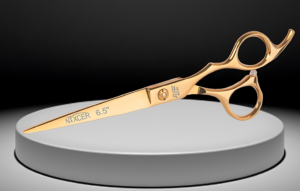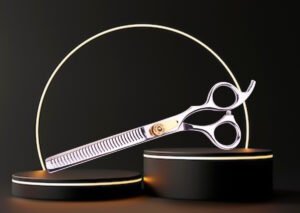Mastering the use of hair cutting scissors is an essential skill for any hairstylist or barber. The way you handle your scissors can significantly impact the quality of the haircut and the overall experience for both you and your client. Whether you’re a seasoned professional or a beginner, these tips will help you use your hair cutting scissors effectively and achieve professional results every time.
1. Choose the Right Scissors for the Job
The first step in using hair cutting scissors effectively is selecting the right pair for the task. Different types of scissors serve specific purposes.
Straight scissors are ideal for blunt cuts, trimming, and creating precise lines. Thinning scissors are used to remove bulk and add texture to the hair without altering the overall length. Texturizing scissors are designed for adding texture and movement, especially in layered or wavy styles.
Using the correct type of scissors ensures you achieve the desired look without damaging the hair.
2. Maintain a Proper Grip
The way you hold your scissors plays a crucial role in the control and precision of your cuts. Here’s the correct grip.
- Insert Your Ring Finger into the top handle hole.
- Place Your Thumb in the bottom handle hole.
- Rest Your Pinky on the finger rest (tang) for added stability.
- Keep Your Middle and Index Fingers outside the handle, resting on the top handle for balance.
This grip allows your thumb to do most of the cutting work while your fingers remain stable, enhancing control and reducing strain.
3. Keep Your Scissors Clean and Sharp
Maintaining your scissors is vital for effective use. Dull blades can cause hair to bend or split rather than cut cleanly, leading to uneven results and potential damage to the hair. Regularly clean your scissors with a soft cloth to remove hair and product residue, and oil the pivot point to keep the movement smooth. Sharpen your scissors professionally every few months, depending on usage, to maintain their performance.
4. Use the Proper Cutting Technique
Different cutting techniques produce varying results, so mastering the appropriate methods is key:
Blunt Cutting: Hold the scissors horizontally and make straight cuts for clean, even lines. This technique is perfect for bobs, blunt bangs, and straight cuts.
Point Cutting: Hold the scissors vertically and snip into the hair ends at an angle. This technique softens the edges and adds texture, perfect for layered styles.
Slide Cutting: Position the scissors slightly open and slide them down the hair shaft, gently trimming as you go. This method is ideal for creating soft layers and blending sections of hair.
Understanding when to use each technique allows you to customize cuts based on the style and hair type.
5. Keep Your Elbow High for Better Control
Maintaining the correct posture when cutting hair can greatly influence the effectiveness of your technique. One key tip is to keep your elbow elevated slightly above your wrist, especially when cutting the sides and top of the head. This positioning keeps your wrist in a natural alignment and helps maintain consistent cutting angles, resulting in cleaner, more precise cuts.
6. Use Sectioning Clips to Divide Hair
Dividing the hair into sections before cutting is crucial for achieving uniform results. Use sectioning clips to separate the hair into manageable parts, usually starting with the back, then moving to the sides, and finally the top. Cutting in sections ensures that you work systematically, maintaining control over the amount of hair being cut at any time. This approach reduces the risk of errors and helps maintain the desired length and shape.
7. Avoid Over-Directing the Hair
Over-directing hair can lead to uneven lengths, particularly when cutting layers. Always ensure you’re pulling the hair in the correct direction relative to the section you’re working on. For straight cuts, comb the hair straight down or at the natural fall. For layers, direct the hair slightly upwards or outwards but avoid pulling too far from the natural growth pattern to maintain balance and symmetry.
8. Check Your Work Frequently
Regularly checking your progress while cutting is essential to ensure accuracy and consistency. Use a comb to comb through the hair frequently, assessing the length and shape of the cut as you go. For precision work, especially with straight hair, use your scissors to make small adjustments, refining the cut as needed. This habit prevents major corrections later and ensures a polished and finish of professional hair cutting scissors .
9. Keep Your Movements Fluid and Consistent
Fluid, consistent movements are key to achieving a smooth cut. Avoid choppy or jerky motions, which can create uneven lines and disrupt the flow of the haircut. Practice moving your scissors in a continuous, controlled manner, using your thumb to drive the cutting motion rather than your entire hand. This technique minimizes the strain on your hand and wrist while providing better control over each snip.
10. Practice Finger Positioning for Layering
When creating layers, the positioning of your fingers plays an important role in controlling the length and angle of the cut. Angle your fingers slightly to match the desired layer gradient and maintain consistent finger positioning throughout the cut. This technique ensures that each section of hair is cut at the correct angle, resulting in smooth, flowing layers rather than choppy or uneven ones.
11. Use the Scissors’ Full Blade Length
To maximize cutting efficiency, use the full length of the scissor blades rather than just the tips. This technique allows you to make longer, smoother cuts with fewer strokes, reducing the risk of jagged or uneven lines. By engaging the entire blade, you also prolong the sharpness of your scissors, as the wear is distributed evenly along the blade.
12. Regularly Adjust the Tension Screw
The tension screw controls how tightly the blades come together when cutting. If the tension is too loose, the hair will bend between the blades, resulting in uneven cuts. If it’s too tight, the scissors will be difficult to open and close, causing hand strain. Regularly adjust the tension screw to ensure your scissors are operating at optimal tension—firm enough to cut cleanly but smooth enough to operate comfortably.
Final Thoughts
Using hair cutting scissors effectively requires attention to detail, proper technique, and regular maintenance. By mastering the right grip, using the correct cutting methods, and maintaining your scissors, you can achieve precise, professional cuts every time. Whether you’re cutting straight lines, creating layers, or adding texture, these tips will help you refine your skills and make the most of your hair cutting scissors.



